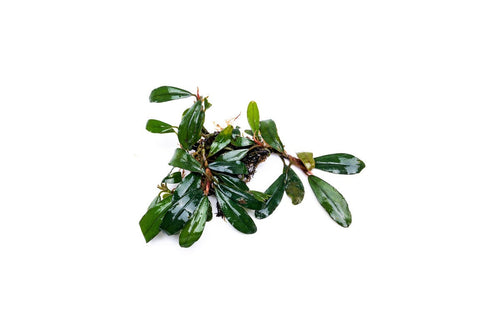

Bucephalandra Giant Motleyana
- $ 7.99
- $ 7.99
Common Name: Bucephalandra Giant Motleyana
Bucephalandra Giant Motleyana is an easy plant, perfect for beginners. It can be grown submerged or immersed. The plant is very slow growing, with new leaves sprouting from long, thin rhizomes. It can be propagated by cutting the rhizome and attached to driftwood and rocks using super glue gel or thread.
Notes:
- Bucephalandra is an epiphytic aquarium plant so it can be attached to aquarium hardscape.
- Do not plant Bucephalandra in substrate and cover the rhizome. This will cause it to melt and rot.
- Please be sure to remove this plant from its pot. Remove the rockwool surrounding the roots and attach to hardscape. For instructions on how to properly prep "potted" aquarium plants, click here .
- Bucephalandra’s final size, coloration and growth rate are dependent upon the condition of the aquarium Photos are a representation of what you will receive and may vary.
- Do not make drastic changes to the aquarium. Unstable parameters will result in melt and rotting of the aquarium plant.
- CO2 injection will yield better growth.
- Please research appropriately to ensure your plant thrives.
Family Name: Araceae
Endemic To: Borneo
Leaves: 1-3 cm
pH: 6-8
Care: Easy
Light: Low to Medium
Co2: Not necessary but recommended
Propagation: Cut by rhizome
Growth rate: Slow
Common Name:
Bucephalandra Giant Motleyana
Bucephalandra Giant Motleyana features elongated dark olive leaves with a blueish shine. round and large leaves, with colors ranging from red to dark green. remarkably tiny leaves displaying an array of deep red, purple, and blue hues. Despite its small size, it's highly prized for its pronounced iridescent coloration with appropriate care and when placed under aquarium LED lighting. This variant is an excellent choice for nano planted tanks, possibly ranking as the smallest among known Bucephalandra variations in the planted aquarium hobby.
As an epiphytic plant, Bucephalandra generates new growth from its rhizome. Optimal results are achieved for Bucephalandra in low to medium lighting conditions, fostering dense growth when provided with favorable circumstances. Faster and more robust growth can be encouraged through CO2 injection, adequate water flow, and consistent tank upkeep. When planting, don't cover the stem and rhizome to prevent plant decay and deterioration. While its care is the same as other popular aquatic species like Anubias and Java Ferns, Bucephalandra is less tolerant of abrupt parameter changes.
Key Features & Important Notes
- Bucephalandra is an epiphytic aquarium plant so it can be attached to aquarium hardscape.
- Do not plant Bucephalandra in substrate and cover the rhizome. This will cause it to melt and rot.
- Please be sure to remove this plant from its pot. Remove the rockwool surrounding the roots and attach to hardscape. For instructions on how to properly prep "potted" aquarium plants, click here.
- Bucephalandra’s final size, coloration and growth rate are dependent upon the condition of the aquarium Photos are a representation of what you will receive and may vary.
- Do not make drastic changes to the aquarium. Unstable parameters will result in melt and rotting of the aquarium plant.
- CO2 injection will yield better growth. Please research appropriately to ensure your plant thrives.
Care & Additional Information
Listed information should be treated as general guidelines only. We encourage you to do thorough research before committing to keeping any type of livestock.
Family Name:
Araceae
Origin:
Borneo
pH:
6-7.5
Skill Level:
Easy
Light:
Low to Medium
Co2:
Not necessary but recommended
Propagation:
Cut by rhizome
Growth rate:
Slow
-
Tweet -
Pin it